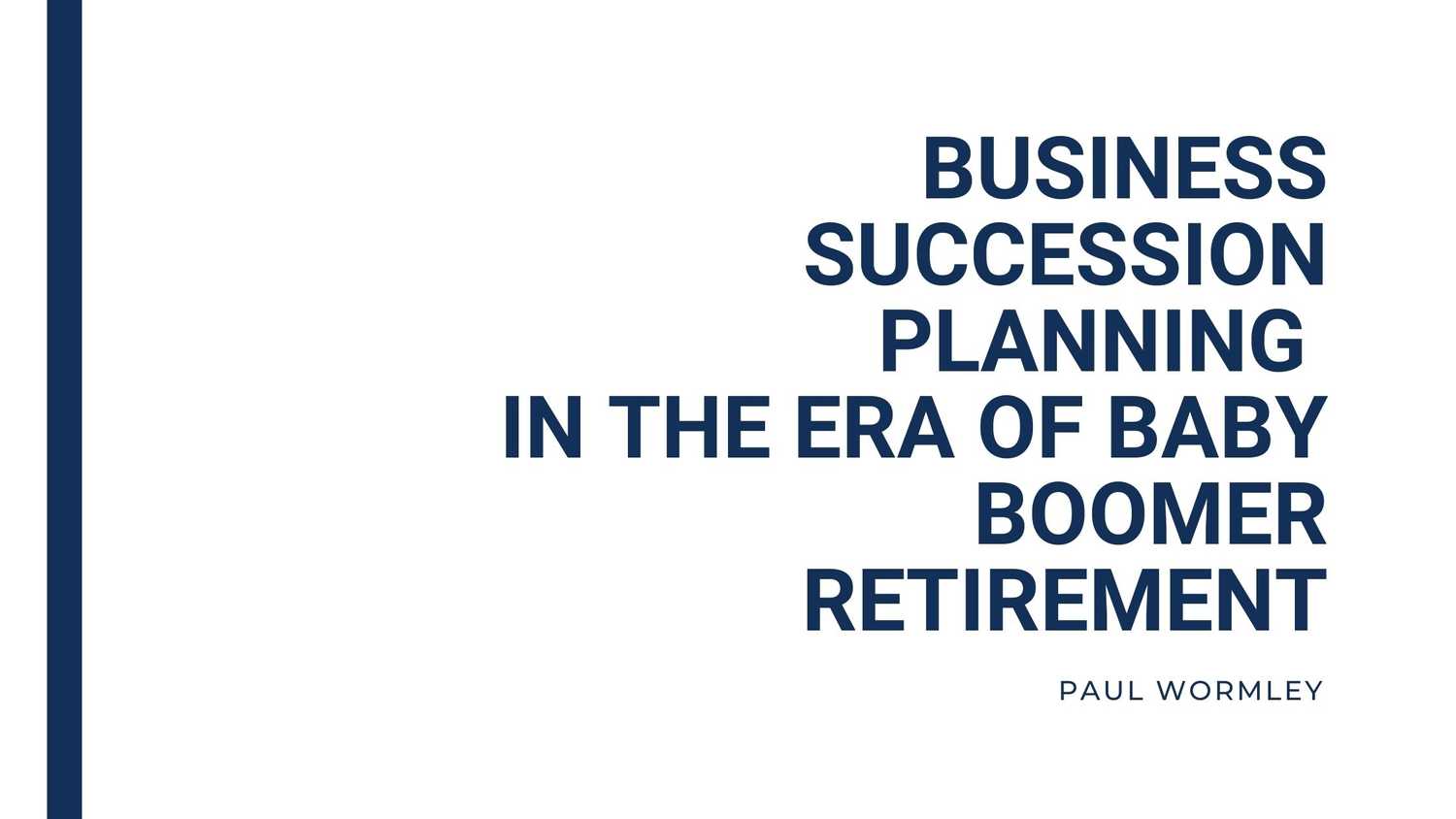Business Succession Planning has always been a process that requires careful consideration and research prior to implementation. This is especially true in the midst of the Baby Boomer Retirement Crisis and it’s for this reason we have decided to write on what to keep in mind during this unique transition.
More than 40% of all small businesses are owned by baby boomers - those post-WWII kids born from 1946 to 1964 - according to a report conducted by Guidant Financial.
About 10 years ago, we wrote a blog post covering how the baby boomer transition might impact small business succession planning and small business mergers and acquisitions.
Today, this demographic fact presents a ticking time bomb for small business succession and transition planning and presents a potential retirement crisis for baby boomers: 10,000+ baby boomers turn 65 years old every day and the oldest boomers will turn 75 in 2021.
Many Baby Boomers retired in the third quarter of last year which means that their millions of dollars worth of assets transferred.
In this blog post, we will cover all the following topics for any businesses planning their exit strategy:
- What is Business Succession Planning?
- How to Write a Business Succession Plan
- The Three Most Common Situations in Management Succession and Ownership Transition
- Options for Baby Boomers Seeking Management Succession and Ownership Transition
What is Business Succession Planning?
At the most basic level, business succession planning is the process whereby a business owner develops a plan for someone else to manage or run the business when the owner is ready to retire (or upon more serious situations like disability or death).
A more comprehensive business succession or transition plan will also take into consideration tax and estate planning, business valuation, and personal goals including philanthropy, hobbies and family legacy.
We consider business succession planning to typically include two elements: Management Succession and Ownership Transition. These two elements may occur simultaneously or individually but each element is an essential part of all succession plans.
How to Write a Business Succession Plan
There are lots of resources available to small business owners on how to write a business succession plan. Here are a few resources to get you started:
- National Federation of Independent Business: Webinar on
- Succession Planning Process
- Succession Planning
- SCORE: Succession Planning Guide
There are also many questions to consider when building a Business Succession Plan.
Trusted advisors to small business owners are also a very good resource when developing plans. Small business accountants and attorneys are good sources of advice and can provide valuable insight into what to consider when developing a comprehensive plan.
The Three Most Common Situations in Management Succession and Ownership Transition
Every small business that Hadley Capital works with faces some element of succession or transition. The three most common situations in small business succession can be seen below:
Family Business Succession Planning
Family business succession generally involves passing management of the business from one generation to the next generation. According to a report from the Great Cities Institute at the University of Illinois at Chicago, three-quarters of family-owned manufacturing companies had baby boomer owners and, and of those, half had no plans for succession. Overall, 62 percent of family-owned manufacturing companies had not designated a specific successor.
Family businesses in need of management succession often look to the next generation to run the business. Many times, the next generation is already involved in some facet of the business operations so should be prepared to take over management. But, this is not always the case.
The next generation may need to be recruited back to the family business. Or, there may be multiple members of the next generation actively involved, presenting some tricky family dynamics. An added complication in family business succession plans is dealing with ownership transition among multiple generations, particularly if the retiring generation needs cash from the sale of a family business in order to comfortably retire.
Hadley Capital has helped multiple family businesses - from 2nd generation up to 6th generation - achieve a successful management succession and concurrent ownership transition. Read more about how we helped the Feldman family in the transition of their family business.
Owner-Managed Business Succession Planning
Owner-Managed Businesses run by Baby Boomers may face the most pressing succession issues. According to the U.S. Census Bureau, baby boomers own 2.34 million small businesses in the United States, employing more than 25 million people. And, a recent survey by Wilmington Trust suggests that nearly 60% of boomers do not have a succession plan.
In our experience, the reason many owner-managed small businesses lack a plan is because these businesses rarely have the management depth to complete a management succession from the owner-manager to an existing employee. A management succession plan for an owner-manager typically involves recruiting someone from outside the business to run the day-to-day operations of the business, allowing the owner-manager to retire.
However, since the business is usually the owner-manager's primary financial asset, the owner-manager must also complete a simultaneous ownership transition in order to secure retirement funds. This presents a particularly complicated problem because the owner-manager is important to the business but also wants to step away.
Hadley Capital has partnered with more than a dozen owner-managers to address the competing goals of most owner-managers: transitioning day-to-day management and securing retirement funds through the sale or recapitalization of the business. We are experts at management succession and ownership transition in small companies, read about one such success story with JRI Industries.
Business Succession Planning for Businesses with Inactive Owners
Businesses with inactive owners have typically already passed through a successful management succession. However, it is not uncommon for businesses with inactive owners to reach a point where the inactive owners want to sell the business, the managers of the business are ready to retire, and/or the managers want to grow the business but the inactive owners are comfortable with the current state.
At this juncture, the company must complete an ownership transition: either the management team and the owners sell the company to a new owner, and/or the managers may elect to buy the company from the inactive owners. If management is ready to retire, the inactive owners are faced with developing a management succession plan.
Over the years, Hadley Capital has helped a number of management teams acquire the businesses they are running from inactive owners. In each case, management had a desire to become owners of the business and to pursue their growth plans just as we achieved in partnership with the management team at Bluff Manufacturing.
Options for Baby Boomers Seeking Management Succession and Ownership Transition
There is no one-size-fits-all solution for baby boomers seeking management succession and ownership transition. As outlined in the prior section, the circumstances of each individual business will vary greatly and, thus, there may be many potential options for management succession and ownership transition or only a select number of options.
Below is a list of 8 common management succession and ownership transition options:
-
Hire a new manager/management team and retain ownership: This option addresses management succession but does not address ownership transition. However, a successful management transition would enable a future ownership transition.
-
Sell to a family member(s): Generational transition achieves the management succession goal. But, most often, the next generation does not have the cash to fund the ownership transition. The most likely solution is for the departing generation to “fund” the ownership transition with a seller note that is repaid over time.
-
Sell your portion of the business to your partner(s): This is a fairly common path among owner/partners, particularly when one partner is older than the other. But, much like a family business, the remaining partner frequently does not have the cash to fund the ownership transition and the departing partner may “fund” the ownership transition with a seller note that is repaid over time.
-
Sell to your employees via an Employee Stock Ownership Plan (ESOP): ESOPs have significant economic benefits related to preferential tax treatment of ESOP contributions and distributions but are also complex and difficult and expensive to maintain. Learn more about ESOPs and some of their challenges in a blog post we wrote a few years ago.
-
Sell to your management team via a management buyout: A management buyout can be an ideal way to address the management succession needs of business owners. But, again, much like a family business, the management team likely does not have the cash to fund the ownership transition and the owner may need to “fund” the ownership transition with a seller note that is repaid over time.
-
Sell to a strategic acquirer: Selling a small business to a strategic acquirer (typically a larger company in your industry) can be an effective way to address management succession because the strategic acquirer can typically provide management oversight. It can also be an effective way to address ownership transition because strategic buyers typically pay cash.
-
Sell to a private investor like Hadley Capital: Experienced small company investors like Hadley Capital are well-positioned to achieve both management succession and ownership transitions through a sale or partial sale/recapitalization.
Hadley Capital can provide management transition support and, at the same time, has the capital necessary to fully fund, in cash, the ownership transition. Hadley Capital also has a substantial amount of flexibility to address the unique situations and circumstances facing business owners, families, and management teams.
-
Do nothing: Believe it or not, in our experience, this is usually the most common option selected by owner-managers and family businesses.
The data regarding the lack of succession plans among small businesses that were referenced earlier in this article would support this position. However, the demographic trends facing small businesses should necessitate a determined focus on developing management succession and ownership transition plans.
Hadley Capital has decades of experience in addressing management succession and ownership transition with small business owners and managers. Achieving a successful management succession and ownership transition plan that addresses the needs of all the stakeholders in a small business requires an experienced partner.
Want to learn more about how a succession and transition of ownership plan could help you achieve your goals? Contact us today.




